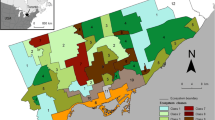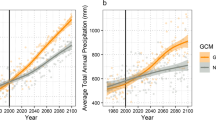Abstract
Forest policymakers, public lands managers, and scientists in the Pacific Northwest (USA) seek ways to evaluate the landscape-level effects of policies and management through the multidisciplinary development and application of spatially explicit methods and models. The Interagency Mapping and Analysis Project (IMAP) is an ongoing effort to generate landscape-wide vegetation data and models to evaluate the integrated effects of disturbances and management activities on natural resource conditions in Oregon and Washington (USA). In this initial analysis, we characterized the spatial distribution of forest and range land development in a four-county pilot study region in central Oregon. The empirical model describes the spatial distribution of buildings and new building construction as a function of population growth, existing development, topography, land-use zoning, and other factors. We used the model to create geographic information system maps of likely future development based on human population projections to inform complementary landscape analyses underway involving vegetation, habitat, and wildfire interactions. In an example application, we use the model and resulting maps to show the potential impacts of future forest and range land development on mule deer (Odocoileus hemionus) winter range. Results indicate significant development encroachment and habitat loss already in 2000 with development located along key migration routes and increasing through the projection period to 2040. The example application illustrates a simple way for policymakers and public lands managers to combine existing data and preliminary model outputs to begin to consider the potential effects of development on future landscape conditions.



Similar content being viewed by others
References
Azuma DL, Dunham PA, Hiserote BA, Veneklase CF (2004) Timber resource statistics for eastern Oregon, 1999. Resource bulletin PNW-RB-238. USDA Forest Service, Pacific Northwest Research Station, Portland, OR, p 42. http://www.fs.fed.us/pnw/pubs/pnw_rb238.pdf
Barbour RJ, Hayes JL, Hemstrom MA (2007) The Interior Northwest Landscape Analysis System: a step toward understanding integrated landscape analysis. Landscape and Urban Planning 80:333–344
Bockstael NE (1996) Modeling economics and ecology: the importance of a spatial perspective. American Journal of Agricultural Economics 78:1168–1180
Cohen JA (1960) A coefficient of agreement for nominal scales. Educational and Psychological Measurement 20:37–46
Duncan J, Burcsu T (2010) Impacts of future residential development on the spatial pattern of mule deer habitat in central Oregon. Manuscript in preparation. On file with: T. Burcsu. Pacific Northwest Research Station, 620 SW Main Street, Suite 400, Portland, OR
Greene WH (1997) Econometric analysis. Prentice Hall, Upper Saddle River, New York
Greene WH (1998) LIMDEP version 7.0: user’s manual, revised edn. Econometric Software, Inc., Plainview, NY
Hemstrom MA, Merzenich J, Reger A, Wales B (2007) Integrated analysis of landscape management scenarios using state and transition models in the upper Grande Ronde River Subbasin, Oregon, USA. Landscape and Urban Planning 80(3):198–211
Judson DH, Reynolds-Scanlon S, Popoff CL (1999) Migrants to Oregon in the 1990’s: working age, near-retirees, and retirees make different destination choices. Rural Development Perspectives 14:24–31
Kline JD (2005) Forest and farmland conservation effects of Oregon’s (USA) land use planning program. Environmental Management 35(4):368–380
Kline JD, Azuma DL, Moses A (2003) Modeling the spatially dynamic distribution of humans in the Oregon (USA) Coast Range. Landscape Ecology 18(4):347–361
Kline JD, Moses A, Lettman G, Azuma DL (2007) Modeling forest and rangeland development in rural locations, with examples from eastern Oregon. Landscape and Urban Planning 80(3):320–332
Kline JD, Lettman GJ, Hemstrom MA (2010). Lessons for landscape planning and ecological assessments. In: Brouwer F, Goetz SJ (eds) The dynamics of land use and ecosystem services; a transatlantic, multidisciplinary and comparative approach. Springer, New York, NY
Land Conservation and Development Committee (LCDC) (1992) Acknowledgement scoreboard, May 12, 1992. Oregon Department of Land Conservation and Development, Salem, Oregon
Laskin D (2004) A town that’s more than a pretty face. New York Times, March 7
Lettman GJ (2004) Land-use change on non-federal land in eastern Oregon, 1975–2001. Oregon Department of Forestry, Salem, Oregon, p 42. http://www.oregon.gov/ODF/STATE_FORESTS/FRP/docs/EORDZ.pdf
Nelson GC, Hellerstein D (1997) Do roads cause deforestation? Using satellite images in econometric analysis of land use. American Journal of Agricultural Economics 79:80–88
Oregon Department of Fish and Wildlife (2003) Oregon’s Mule Deer Management Plan. Oregon Department of Fish and Wildlife, Salem, OR, p 29. http://www.dfw.state.or.us/wildlife/management_plans/docs/MuleDeerPlanFinal.PDF
Oregon Department of Fish and Wildlife (2009a) Mule Deer Initiative Planning Committee meets May 28 in Prineville. News release, May 22. Oregon Department of Fish and Wildlife, Salem, OR. http://www.dfw.state.or.us/news/2009/may/052209e.asp
Oregon Department of Fish and Wildlife (2009b) Oregon Mule Deer Initiative. Oregon Department of Fish and Wildlife, Salem, OR. http://www.dfw.state.or.us/wildlife/hot_topics/mule_deer_initiative.asp
Oregon Office of Economic Analysis (2004) Forecasts of Oregon’s county populations and components of change, 2000–2040. Department of Administrative Services, Salem, Oregon
Proehl RS (2009) Certified population estimates for Oregon and Oregon Counties. Population Research Center, College of Urban and Public Affairs, Portland State University, Portland OR, p 3
Preusch M (2004) Journeys: 36 hours: bend, ore. New York Times, October 15
Spies TA, Johnson KN, Burnett KM, Ohmann JL, McComb BC, Reeves GH, Bettinger P, Kline JD, Garber-Yonts B (2007) Cumulative ecological and socio-economic effects of forest policies in coastal Oregon. Ecological Applications 17(1):5–17
Stein SM, Alig RJ, White EM, Comas SJ, Carr M, Eley M, Elverum K, O’Donnell M, Theobald DM, Cordell K, Haber J, Beauvais TW (2007) National forests on the edge: development pressures on America’s national forests and grasslands. General Technical Report PNW-GTR-728. USDA Forest Service, Pacific Northwest Research Station, Portland, OR, p 26
Theobald DM, Miller JR, Hobbs NT (1997) Estimating the cumulative effects of development on wildlife habitat. Landscape and Urban Planning 39:25–36
US Department of Commerce, Census Bureau (2000) Population estimates for states, counties, places, and minor civil divisions: annual time series. U.S. Department of Commerce, Washington, DC
Vogel WO (1989) Response of deer to density and distribution of housing in Montana. Wildlife Society Bulletin 17:406–413
Wear DN, Bolstad P (1998) Land-use changes in southern Appalachian landscapes: spatial analysis and forecast evaluation. Ecosystems 1:575–594
Wimberly MC, Ohmann JL (2004) A multi-scale assessment of human and environmental constraints on forest land cover change on the Oregon (USA) coast range. Landscape Ecology 19:631–646
Acknowledgments
Funding for this article was provided by the Interagency Mapping and Analysis Project (IMAP), USDA Forest Service, Pacific Northwest Research Station, Portland, Oregon. We thank Dave Azuma, Miles Hemstrom, Gary Lettman, and two anonymous reviewers for helpful comments.
Author information
Authors and Affiliations
Corresponding author
Rights and permissions
About this article
Cite this article
Kline, J.D., Moses, A. & Burcsu, T. Anticipating Forest and Range Land Development in Central Oregon (USA) for Landscape Analysis, with an Example Application Involving Mule Deer. Environmental Management 45, 974–984 (2010). https://doi.org/10.1007/s00267-010-9470-x
Received:
Accepted:
Published:
Issue Date:
DOI: https://doi.org/10.1007/s00267-010-9470-x




